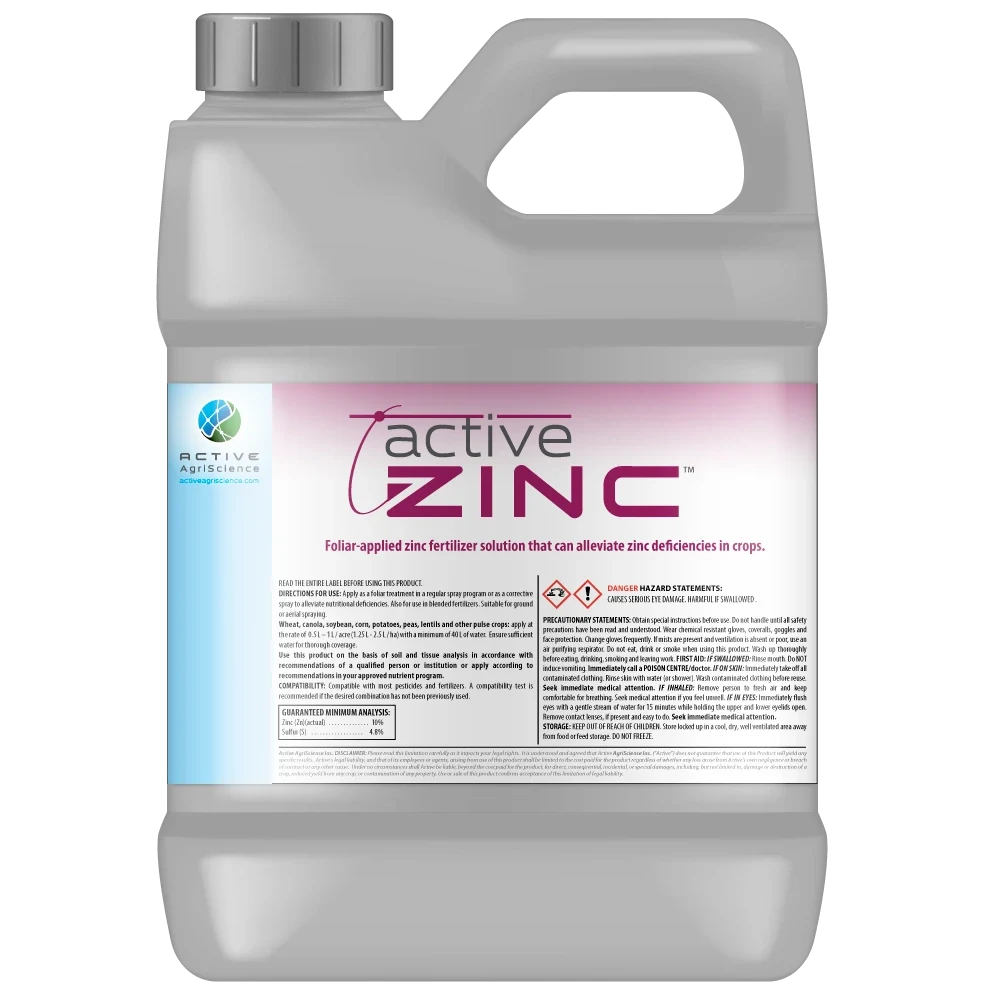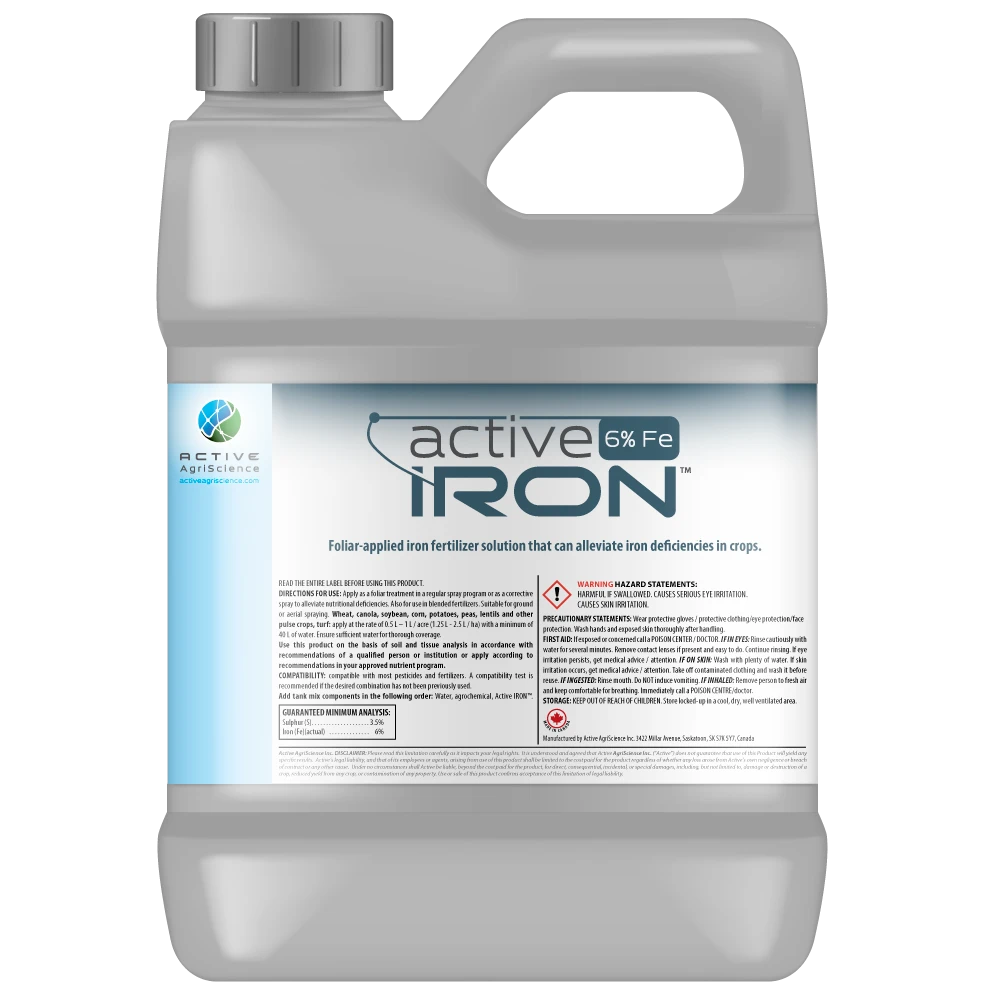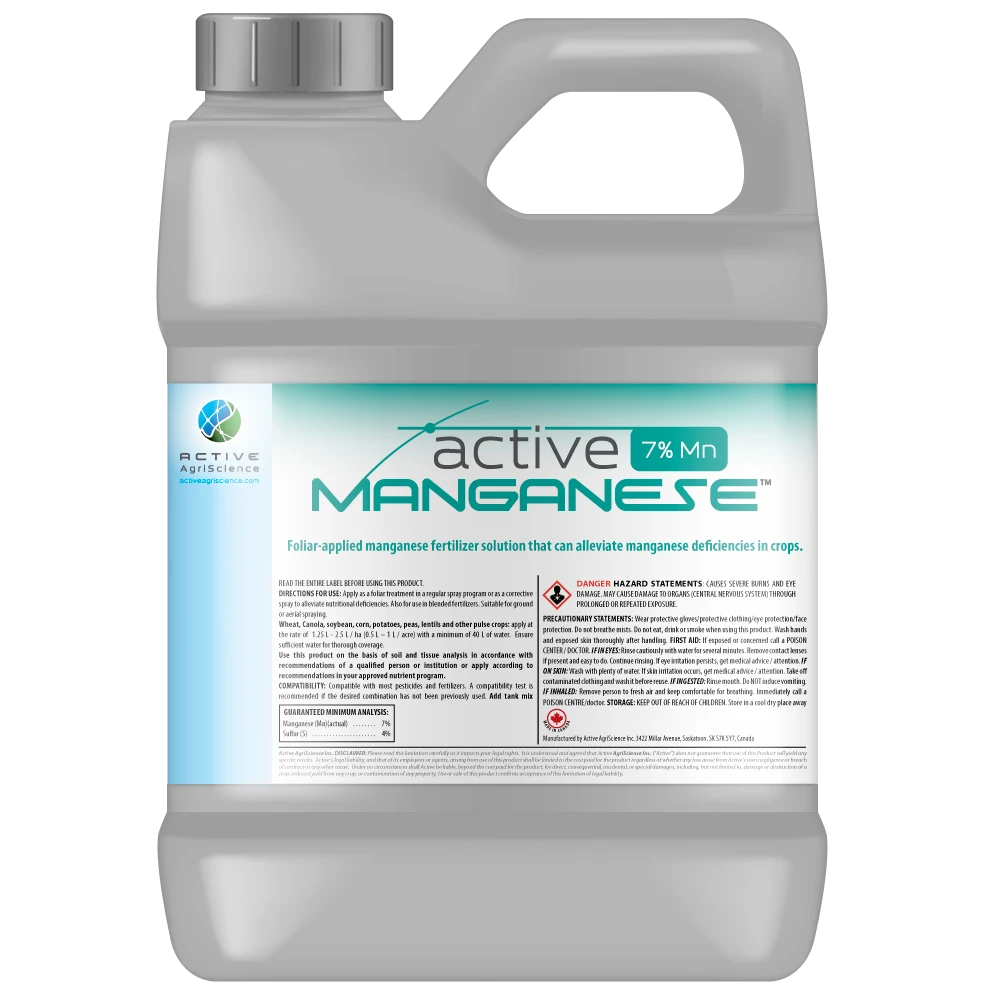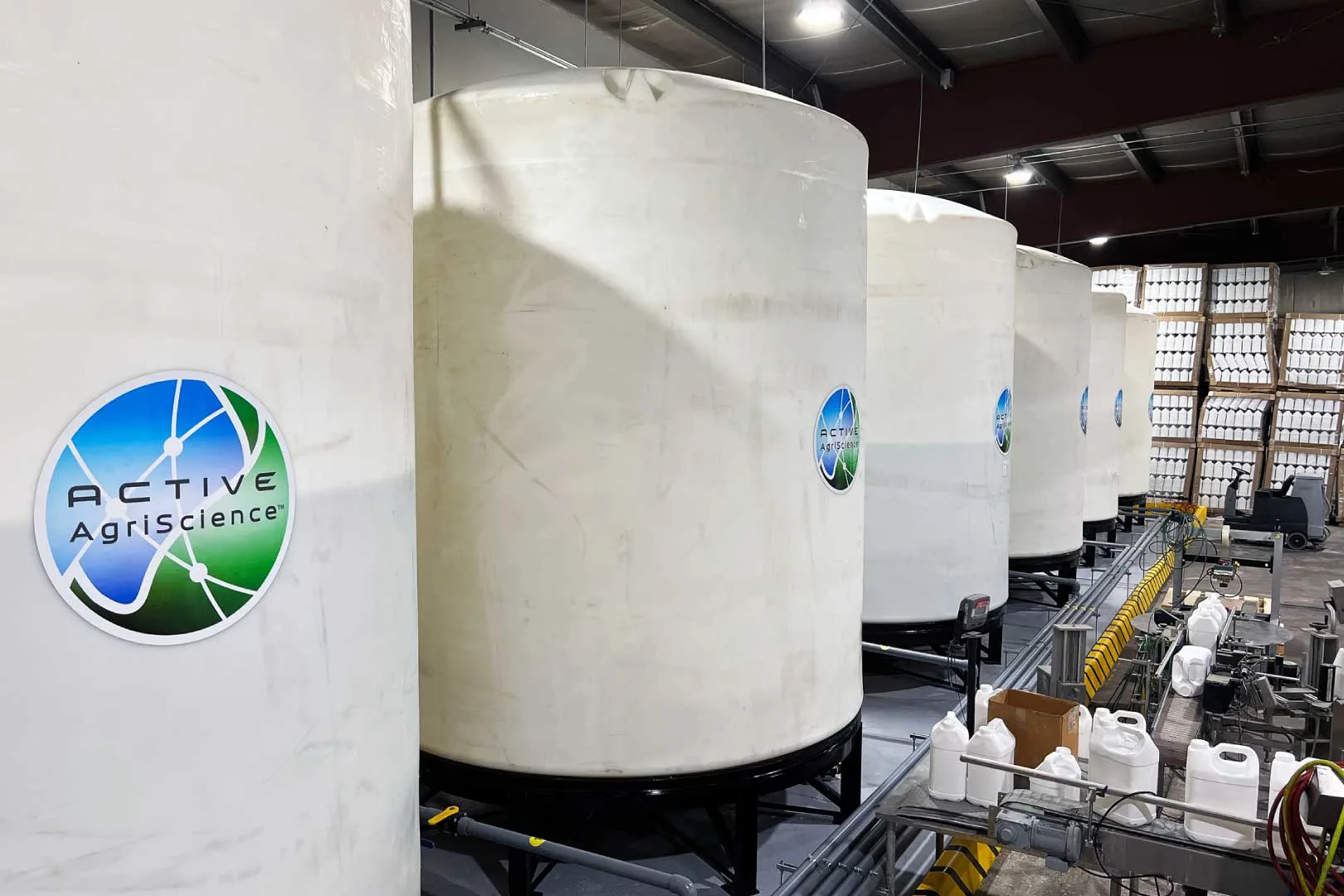
Active Zinc™
Active Zinc™ is a foliar-applied zinc fertilizer solution that can alleviate zinc deficiencies in crops.

Active Zinc™ is a foliar-applied zinc fertilizer solution that can alleviate zinc deficiencies in crops.
Active Zinc™ contains zinc which is essential for plant enzymatic processes, including photosynthesis and the production of indoleacetic acid, affecting stem length and leaf size.
As indicated by soil analysis, prior to seeding or with starter fertilizer. Too much zinc can be harmful, particularly to cereal crops, so soil analysis testing is necessary, and amounts needed vary by crop.
If soil temperatures remain cool during spring planting and early growth, zinc supplementation may be particularly beneficial. Some crops however, may not require additional zinc, and caution is needed to avoid zinc toxicity.
Although micronutrients are needed in smaller quantities than primary and secondary nutrients, they are essential for strong, healthy growth and high yields. Insufficiency of micronutrients in the soil can limit growth, even when all other nutrients are present in adequate amounts. Active Zinc™ is a foliar-applied micronutrient for fast correction of zinc deficiency. Also for use in blended fertilizers.
Active Zinc Supports:
For the best results, use the complete line of recommended Active AgriScience™ products for your crop.
10% Zn
HELPS CORRECT ZINC DEFICIENCIES
A foliar-applied zinc fertilizer solution that can alleviate zinc deficiencies in crops.
DIRECTIONS FOR USE:
READ THE ENTIRE LABEL BEFORE USING THIS PRODUCT. Apply as a foliar treatment in a regular spray program or as a corrective spray to alleviate nutritional deficiencies. Also for use in blended fertilizers. Suitable for ground or aerial spraying.
Wheat, canola, soybean, corn, potatoes, peas, lentils and other pulse crops: Apply at the rate of 0.5 L – 1 L / acre (1.25 L – 2.5 L / ha) with a minimum of 40 L of water. Ensure sufficient water for thorough coverage.
Use this product on the basis of soil and tissue analysis in accordance with recommendations of a qualified person or institution or apply according to recommendations in your approved nutrient program.
COMPATIBILITY: compatible with most pesticides and fertilizers. A compatibility test is recommended if the desired combination has not been previously used.
Add tank mix components in the following order:
Water, Agrochemical, Active Zinc™ 10% Zn. Keep agitator running while mixing and spraying.
WARRANTY AND CONDITIONS OF SALE: Manufacturer warrants that this material conforms to the chemical description hereon and is reasonably fit for use as directed. No other warranty is made, either expressed or implied.
GUARANTEED MINIMUM ANALYSIS:
Registration number: 2016122M Fertilizers Act.
DANGER HAZARD STATEMENTS: CAUSES SERIOUS EYE DAMAGE. HARMFUL IF SWALLOWED.
CAUTION: THIS FERTILIZER CONTAINS ZINC AND SHOULD BE USED ONLY AS RECOMMENDED. IT MAY PROVE HARMFUL WHEN MISUSED. STORE IN A COOL, DRY AREA. DO NOT FREEZE.
PRECAUTIONARY STATEMENTS: Obtain special instructions before use. Do not handle until all safety precautions have been read and understood. Wear chemical resistant gloves, coveralls, goggles and face protection. Change gloves frequently. If mists are present and ventilation is absent or poor, use an air purifying respirator. Do not eat, drink or smoke when using this product. Wash up thoroughly before eating, drinking, smoking and leaving work.
FIRST AID: IF SWALLOWED: Rinse mouth. Do NOT induce vomiting. Immediately call a POISON CENTRE/doctor. IF ON SKIN: Immediately take off all contaminated clothing. Rinse skin with water (or shower). Wash contaminated clothing before reuse. Seek immediate medical attention. IF INHALED: Remove person to fresh air and keep comfortable for breathing. Seek medical attention if you feel unwell. IF IN EYES: Immediately flush eyes with a gentle stream of water for 15 minutes while holding the upper and lower eyelids open. Remove contact lenses, if present and easy to do. Seek immediate medical attention.
STORAGE: KEEP OUT OF REACH OF CHILDREN. Store locked up in a cool, dry, well ventilated area away from food or feed storage. DO NOT FREEZE.
DISPOSAL: Dispose of this product and its container in accordance with Federal, Provincial, and Local regulations.
FOR CHEMICAL EMERGENCY: Call +1 877-715-9305 and refer to SDS.
For Product Inquiries call 1-639-398-0485 or visit activeagriscience.com.
Manufactured by Active AgriScience Inc.: 3422 Millar Avenue, Saskatoon, SK S7K 5Y7, Canada
Active AgriScience Inc. DISCLAIMER: Please read this limitation carefully as it impacts your legal rights. It is understood and agreed that Active AgriScience Inc. (“Active”) does not guarantee that use of this Product will yield any specific results. Active’s legal liability, and that of its employees or agents, arising from use of this product shall be limited to the cost paid for the product regardless of whether any loss arose from Active’s own negligence or breach of contract or any other cause. Under no circumstances shall Active be liable, beyond the cost paid for the product, for direct, consequential, incidental, or special damages, including, but not limited to, damage or destruction of a crop, reduced yield from any crop, or contamination of any property. Use or sale of this product confirms acceptance of this limitation of legal liability.
Net weight:
13.3 kg (29.2 lbs)
Net contents:
10 L (2.6 gal)
Compatible with most pesticides and fertilizers. Please see Compatibility Chart and conduct pre-testing if combination has not been previously used. Always do a jar test with pesticides and spray water to ensure compatibility as water quality can vary.
| FERTILIZERS | ACTIVE INGREDIENTS | |
|---|---|---|
| √ | ATS | Ammonium thiosulfate |
| √ | KTS | Potassium thiosulfate |
| X | UAN | Urea ammonium nitrate |
| X | 10-34-0 | Ammonium poly phosphate |
| AAS FERTILIZERS | |
|---|---|
| X | Active Boron |
| √ | Active BUILD |
| √ | Active Copper |
| X | Active FLOWER |
| X | Active GrainFILL |
| √ | Active INFURROW |
| √ | Active Iron |
| X | Active KONNECT |
| √ | Active Manganese |
| X | Active PodFILL |
| √ | Active PRIME |
| X | Active VPR PLUS |
| √ | Active Zinc |
| √ | Proform N |
| SECTION 1 – CHEMICAL PRODUCT AND COMPANY IDENTIFICATION | |
| PRODUCT IDENTIFIER | Active Zinc |
| PRODUCT USE | Agricultural fertilizer |
| MANFACTURERS NAME | Active AgriScience Inc. |
| STREET ADDRESS | 3422 Millar Avenue |
| CITY | Saskatoon |
| POSTAL CODE | S7K 5Y7 |
| DATE | July 9, 2021 |
| PROVINCE | Saskatchewan, Canada |
| EMERGENCY TELEPHONE | +1 877-715-9305 |
| PREPARED BY | Active AgriScience Inc. |
| USE RESTRICTIONS | For professional use only. Use only as labeled. |
| DISTRIBUTORS NAME | |
| STREET ADDRESS | |
| CITY | |
| POSTAL CODE | |
| COUNTRY | |
| EMERGENCY TELEPHONE | |
| SECTION 2 – HAZARDS IDENTIFICATION | |
| GHS CLASSIFICATION | |
| HPR (WHMIS 2015) | Eye Damage / Irritation: Category 1 Acute Toxicity Oral: Category 4 |
| OSHA Hazard Communication Standard (29 CFR 1910.1200) | Eye Damage / Irritation: Category 1 Acute Toxicity Oral: Category 4 |
DANGER |
HAZARD STATEMENTS: CAUSES SERIOUS EYE DAMAGE. HARMFUL IF SWALLOWED. PRECAUTIONARY STATEMENTS: Obtain special instructions before use. Do not handle until all safety precautions have been read and understood. Wear chemical resistant gloves, coveralls, goggles and face protection. Change gloves frequently. If mists are present and ventilation is absent or poor, use an air purifying respirator. Do not eat, drink or smoke when using this product. Wash up thoroughly before eating, drinking, smoking and leaving work. FIRST AID: IF SWALLOWED: Rinse mouth. Do NOT induce vomiting. Immediately call a POISON CENTRE/doctor. IF ON SKIN: Immediately take off all contaminated clothing. Rinse skin with water (or shower). Wash contaminated clothing before reuse. Seek immediate medical attention. IF INHALED: Remove person to fresh air and keep comfortable for breathing. Seek medical attention if you feel unwell. IF IN EYES: Immediately flush eyes with a gentle stream of water for 15 minutes while holding the upper and lower eyelids open. Remove contact lenses, if present and easy to do. Seek immediate medical attention. STORAGE: KEEP OUT OF REACH OF CHILDREN. Store locked up in a cool, dry, well ventilated area away from food or feed storage. DO NOT FREEZE. DISPOSAL: Dispose of this product and its container in accordance with Federal, Provincial, and Local regulations. |
| SECTION 3 – COMPOSITION / INFORMATION ON INGREDIENTS | ||
| INGREDIENTS | CAS# | CONCENTRATION |
| Zinc sulphate monohydrate | 7746-19-7 | 25% |
| SECTION 4 – FIRST AID MEASURES | |
| EYE CONTACT | Immediately flush eyes with a gentle stream of water for 15 minutes while holding the upper and lower eyelids open. Remove contact lenses, if present and easy to do. Seek immediate medical attention. |
| SKIN CONTACT | Immediately take off all contaminated clothing. Rinse skin with water (or shower). Wash contaminated clothing before reuse. Seek immediate medical attention. |
| INHALATION | Remove person to fresh air and keep comfortable for breathing. Seek medical attention if you feel unwell. |
| INGESTION | Rinse mouth. Do NOT induce vomiting. Immediately call a POISON CENTRE/doctor. |
| Most Important Symptoms, both acute & delayed | Causes serious eye damage. |
| SECTION 5 – FIRE FIGHTING MEASURES | |
| FLAMMABLE | Product will not burn or support combustion. |
| MEANS OF EXTINCTION | Use extinguishing methods appropriate for the surrounding fire. |
| FLASHPOINT & METHOD | NAP |
| UPPER FLAMMABLE LIMIT | NAP |
| LOWER FLAMMABILITY LIMIT | NAP |
| AUTO IGNITION TEMPERATURE | NAP |
| SENSITIVITY TO IMPACT | NAP |
| SENSITIVITY TO STATIC DISCHARGE | NAP |
| HAZARDOUS COMBUSTION PRODUCTS | Toxic sulphur oxides and / or zinc oxides can be released during a fire or when product is heated to decomposition. |
| SECTION 6 – ACCIDENTAL RELEASE MEASURES | |
| LEAK & SPILL PROCEDURES | Wear personal protective equipment outlined in SECTION 8. Ventilate area of spill. Avoid breathing mists. Contain spill then adsorb with inert material and place into suitable clean containers for later disposal. Do not release into drains or the environment. |
| SECTION 7 – HANDLING AND STORAGE | |
| HANDLING | Do not handle until all safety precautions have been read and understood. Do not breathe mist/spray. Do not get in eyes, or skin. Wear personal protective equipment outlined in SECTION 8. Wash hands and other exposed areas before eating, drinking, smoking and when leaving work. |
| STORAGE | KEEP OUT OF REACH OF CHILDREN. Store locked up in a cool, dry, well ventilated area away from food or feed storage. DO NOT FREEZE. |
| SECTION 8 – EXPOSURE CONTROL / PERSONAL PROTECTION | |
| EXPOSURE LIMITS | Not available. |
| ENGINEERING CONTROLS | Ensure adequate ventilation when handling or applying this product. Follow all label instructions. Follow manufacturers’ instructions for cleaning / maintaining personal protective equipment. If mists are present and ventilation is absent or poor, use an air purifying respirator. |
| PERSONAL PROTECTIVE EQUIPMENT | |
| Skin | Wear chemical resistant gloves, coveralls and face protection when handling or applying this product. Change gloves frequently. |
| Eyes | Wear chemical resistant goggles when handling or applying this product. |
| Respirator | If mists are present and ventilation is absent or poor, use an air purifying respirator when handling or applying this product. |
| SECTION 9 – PHYSICAL AND CHEMICAL PROPERTIES | |
| PHYSICAL STATE | Liquid |
| COLOUR | Clear |
| BOILING POINT | NAV |
| EVAPORATION RATE | NAV |
| ODOUR | NAV |
| SOLUBILITY IN WATER | Soluble |
| APPEARANCE | Clear liquid |
| VISCOSITY | NAV |
| FREEZING POINT | NAV |
| SPECIFIC GRAVITY | 1.3- 1.4 g/cm3 |
| pH | 1.2 – 1.5 |
| ODOUR THRESHHOLD | NAV |
| SECTION 10 – STABILITY AND REACTIVITY | |
| CHEMICAL STABILITY | Stable under normal conditions of use and storage. |
| INCOMPATIBLE WITH OTHER SUBSTANCES | Not available. |
| HAZARDOUS DECOMPOSING PRODUCTS | Toxic sulphur oxides and / or zinc oxides can be released during a fire or when heated to decomposition. |
| SECTION 11 – TOXICOLOGICAL INFORMATION | |
| ACUTE TOXICITY | Zinc sulphate is classified as Category 4 for oral toxicity (LD50: > 300 ≤ 2000 mg/kg of body weight). |
| CHRONIC TOXICITY | Prolonged or repeated skin exposure can lead to severe dermatitis. Exposure to high levels of mists can lead to thirst, a metallic taste in the mouth, weakness, fatigue muscular pain and nausea. |
| EYE / SKIN IRRITATION | Causes serious eye damage. |
| SENSITIZATION | Not available. |
| CARCINOGENICITY | No component of this product present at levels ≥ 0.1% is identified as a probable, possible, or confirmed human carcinogen by IARC, or ACGIH. |
| REPRODUCTIVE TOXICITY | Some evidence in rats (RTECS). |
| MUTAGENICITY | Some evidence in microorganisms, rodents and in vitro human cells (RTECS). |
| SECTION 12 – ECOLOGICAL INFORMATION | |
| ECOTOXICITY | Very harmful to aquatic life in low concentrations with possible long-term effects. |
| SECTION 13 – DISPOSAL CONSIDERATIONS | |
| WASTE DISPOSAL | Dispose of this product and its container in accordance with Federal, Provincial, and Local regulations. |
| SECTION 14 – TRANSPORT INFORMATION | |
| SHIPPING | TDG: Not a dangerous good for transport. DOT: Not a dangerous good for transport. |
| SECTION 15 – REGULATORY INFORMATION |
| This SDS is prepared to comply with the Global Harmonized System of Chemical Classification and Labeling (GHS) and conforms to the requirements of HPR (WHMIS 2015) & OSHA Hazard Communication Standard (29 CFR 1910.1200). |
| SECTION 16 – OTHER INFORMATION |
| To the best of our knowledge, the information contained herein is current and correct as of the date of this SDS, however, the information and recommendations are presented without warranty, representation or license of any kind, with respect to their accuracy, or completeness, and the seller, supplier and manufacturer (Supplier) of this material or their affiliates, disclaim all liability for reliance on such information and recommendations. Final determination of the suitability of any material is the sole responsibility of the buyer or the user (recipient). All materials may present unknown hazards and should be used with caution. The recipient assumes all risk in connection with the use of this material and assumes all responsibility for ensuring the material is used in a safe manner in compliance with applicable environmental, health and safety laws. The supplier does not warrant the merchantability of this material or the fitness of the material for any particular use and assumes no responsibility for injury or damage caused directly or indirectly by the use of this material. |
The entirety of our products at Active AgriScience Inc. undergo third party testing and are retested with any change in formula.
13611 B Street • Omaha, Nebraska 68144-3693 • (402) 334-7770
www.midwestlabs.com
Sample ID: Active ZINC
Lab Number: 8801819
| Arsenic (total) | |
|---|---|
| Level Found | < 5.0 |
| Units | mg/kg |
| Reporting Limit | 5 |
| Method | EPA 6010 |
| Analyst Date | ery3-2020/09/11 |
| Verified Date | trh1-2020/09/11 |
| Cadmium (total) | |
|---|---|
| Level Found | < 0.50 |
| Units | mg/kg |
| Reporting Limit | 0.5 |
| Method | EPA 6010 |
| Analyst Date | ery3-2020/09/11 |
| Verified Date | trh1-2020/09/11 |
| Chromium (total) | |
|---|---|
| Level Found | < 1.00 |
| Units | mg/kg |
| Reporting Limit | 1 |
| Method | EPA 6010 |
| Analyst Date | ery3-2020/09/11 |
| Verified Date | trh1-2020/09/11 |
| Cobalt (total) | |
|---|---|
| Level Found | < 1.00 |
| Units | mg/kg |
| Reporting Limit | 1 |
| Method | EPA 6010 |
| Analyst Date | ery3-2020/09/11 |
| Verified Date | trh1-2020/09/11 |
| Copper (total) | |
|---|---|
| Level Found | 6.7 |
| Units | mg/kg |
| Reporting Limit | 1 |
| Method | EPA 6010 |
| Analyst Date | ery3-2020/09/11 |
| Verified Date | trh1-2020/09/11 |
| Mercury (total) | |
|---|---|
| Level Found | < 0.05 |
| Units | mg/kg |
| Reporting Limit | 0.05 |
| Method | EPA 7471 |
| Analyst Date | pjd8-2020/09/10 |
| Verified Date | trh1-2020/09/11 |
| Molybdenum (total) | |
|---|---|
| Level Found | < 1.0 |
| Units | mg/kg |
| Reporting Limit | 1 |
| Method | EPA 6010 |
| Analyst Date | ery3-2020/09/11 |
| Verified Date | trh1-2020/09/11 |
| Nickel (total) | |
|---|---|
| Level Found | < 1.0 |
| Units | mg/kg |
| Reporting Limit | 1 |
| Method | EPA 6010 |
| Analyst Date | ery3-2020/09/11 |
| Verified Date | trh1-2020/09/11 |
| Lead (total) | |
|---|---|
| Level Found | < 5.0 |
| Units | mg/kg |
| Reporting Limit | 5 |
| Method | EPA 6010 |
| Analyst Date | ery3-2020/09/11 |
| Verified Date | trh1-2020/09/11 |
| Selenium (total) | |
|---|---|
| Level Found | < 10.0 |
| Units | mg/kg |
| Reporting Limit | 10 |
| Method | EPA 6010 |
| Analyst Date | ery3-2020/09/11 |
| Verified Date | trh1-2020/09/11 |
| Zinc (total) | |
|---|---|
| Level Found | 104900 |
| Units | mg/kg |
| Reporting Limit | 2 |
| Method | EPA 6010 |
| Analyst Date | ery3-2020/09/11 |
| Verified Date | trh1-2020/09/11 |
| Sulfur (total) | |
|---|---|
| Level Found | 4.93 |
| Units | % |
| Reporting Limit | 0.05 |
| Method | MWL ME PROC 26 |
| Analyst Date | trh1-2020/09/09 |
| Verified Date | tat9-2020/09/11 |
For questions please contact:
Rob Ferris
Account Manager
(402)-829-9871
[email protected]
Sample(s) was prepared for EPA 6010 analysis by EPA 3050b.
*All results are reported on an AS RECEIVED basis, ppm = parts per million, ppm = mg/kg.
The result(s) issued on this report only reflect the analysis of the sample(s) submitted.
Our reports and letters are for the exclusive and confidential use of our clients and may not be reproduced in whole or in part, nor may any reference be made to the work, the results, or the company in any advertising, news release, or other public announcements without obtaining our prior written authorization.

Active IRON™ 6 % Fe is a foliar-applied iron fertilizer solution that can alleviate iron deficiencies in crops.

Active BORON™ is a foliar-applied boron fertilizer solution that can alleviate boron deficiencies in crops.

Active COPPER™ is a foliar-applied copper fertilizer solution that can alleviate copper deficiencies in crops.

Active Manganese™ 7% Mn is a foliar-applied manganese fertilizer solution that can correct manganese deficiencies in crops.

Determine whether your crop has any nutritional deficiencies that might limit its yield.

With unexpected variables such as soil conditions, weather, pests, diseases, tank mix partners, applications rates, and errors in mixing and application, we encourage all prospective customers to run trials of our products before broad acreage adoption. Please visit our Trial Protocol page to learn more.

A guide for proper storage and handling of Active AgriScience products to ensure their long-term efficacy.

Active AgriScience products are compatible with most pesticides and fertilizers. Please read the Compatibility Guide and conduct pre-testing if a combination has not been previously used.
Active AgriScience has sales representatives that help us support farmers across the globe. Please find the sales rep closest to you and contact them about our products.
